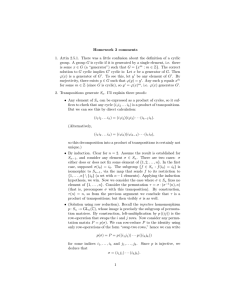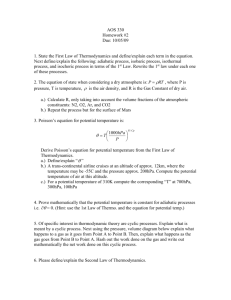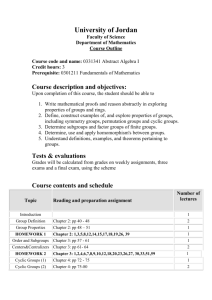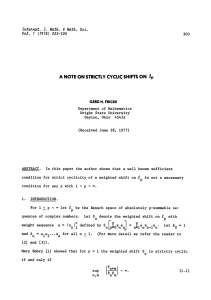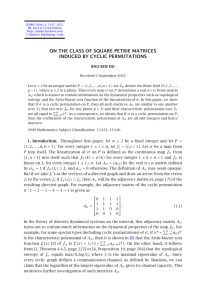ex1214-3-sol-2013 March 15, 2015
advertisement
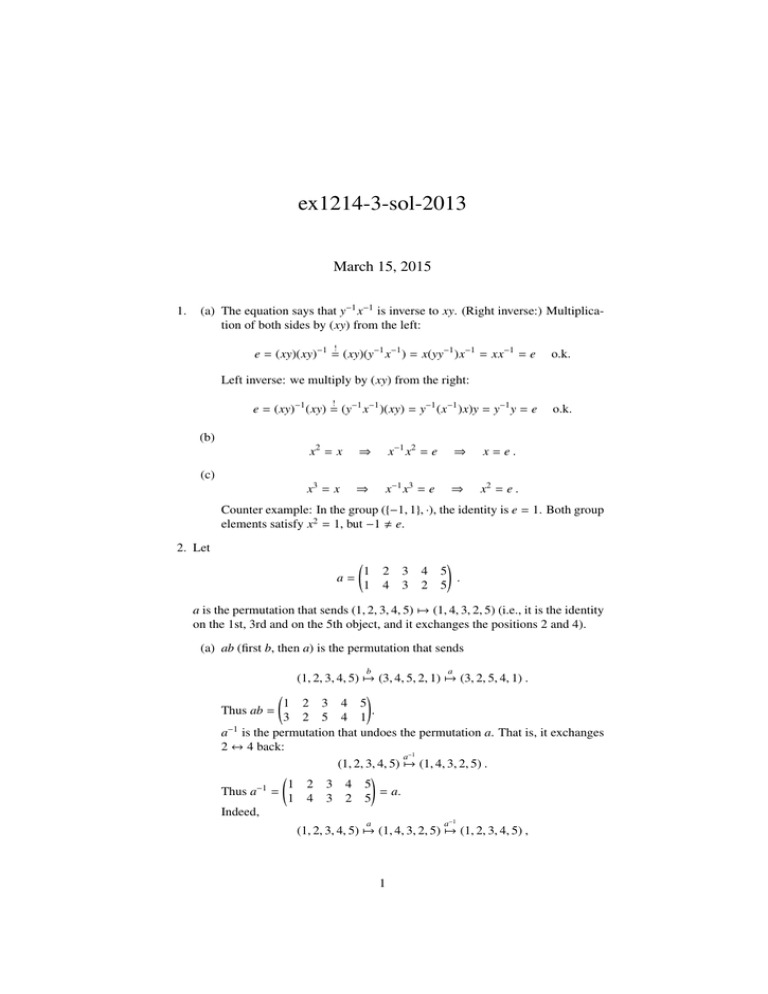
ex1214-3-sol-2013
March 15, 2015
1.
(a) The equation says that y−1 x−1 is inverse to xy. (Right inverse:) Multiplication of both sides by (xy) from the left:
!
e = (xy)(xy)−1 = (xy)(y−1 x−1 ) = x(yy−1 )x−1 = xx−1 = e
o.k.
Left inverse: we multiply by (xy) from the right:
!
e = (xy)−1 (xy) = (y−1 x−1 )(xy) = y−1 (x−1 )x)y = y−1 y = e
o.k.
(b)
x2 = x
⇒
x−1 x2 = e
⇒
x=e.
x3 = x
⇒
x−1 x3 = e
⇒
x2 = e .
(c)
Counter example: In the group ({−1, 1}, ·), the identity is e = 1. Both group
elements satisfy x2 = 1, but −1 , e.
2. Let
1
a=
1
2
4
3
3
4
2
!
5
.
5
a is the permutation that sends (1, 2, 3, 4, 5) 7→ (1, 4, 3, 2, 5) (i.e., it is the identity
on the 1st, 3rd and on the 5th object, and it exchanges the positions 2 and 4).
(a) ab (first b, then a) is the permutation that sends
b
a
a
a−1
(1, 2, 3, 4, 5) 7→ (3, 4, 5, 2, 1) 7→ (3, 2, 5, 4, 1) .
!
1 2 3 4 5
Thus ab =
.
3 2 5 4 1
a−1 is the permutation that undoes the permutation a. That is, it exchanges
2 ↔ 4 back:
a−1
(1, 2, 3, 4, 5) 7→ (1, 4, 3, 2, 5) .
!
1 2 3 4 5
−1
Thus a =
= a.
1 4 3 2 5
Indeed,
(1, 2, 3, 4, 5) 7→ (1, 4, 3, 2, 5) 7→ (1, 2, 3, 4, 5) ,
1
1
so a a =
1
−1
2
2
a−1 =
3
3
1
1
!
5
= e is the identity. and
5
4
4
4
2
3
3
!
5
10
= 0
5
1
2
4
20
40
30
30
40
20
!
50
=a
50
(rename 20 = 4 and 40 = 2).
(b) We have to solve
1
ax =
1
2
4
3
3
!
5 1
5 x1
4
2
2
x2
3
x3
4
x4
!
5
1
=
x5
3
2
4
3
5
4
2
!
5
=b
1
Now
b(1, 2, 3, 4, 5) = (3, 4, 5, 2, 1) = a(3, 2, 5, 4, 1) ,
so
x(1, 2, 3, 4, 5) = (x1 , x2 , x3 , x4 , x5 ) = (3, 2, 5, 4, 1) .
!
1 2 3 4 5
We conclude that x =
.
3 2 5 4 1
(c) As a permutation,
b=
1
3
2
4
3
5
4
2
1
3
5
=
1
3
3
!
2
2
4
4
3
1
1
5
4
4
2
2
5
5
5
1
Here we have inserted rows (intermediate steps of the permutation) so that
each row differs from the respective previous row by one transposition (exchange of two positions) only. The first transposition exchanges 1 and 3
(denoted by (1 3)), and the whole series of transpositions is
b = (1 5)(2 4)(1 3) .
Since the number of permutations is odd, the sign is −1.
Note: While the decomposition is not unique, the sign will always remain
the same.
(d)
b = (1, 3, 5)(2, 4) = (2, 4)(1, 3, 5) .
3.
(a) S 2 = {(1), (1 2)} is cyclic. Explanation: (1 2)2 = (1).
(b) nZ ⊂ Z is cyclic. Explanation: (Z, +) is (infinite) cyclic, and (nZ, +) is a
subgroup generated by single element n, thus cyclic.
(c) (Q, +) is not cyclic. Explanation: Otherwise there would exist a, b ∈ Z,
b , 0 such that a/b were a single generator of Z, for instance
a
a
=n
2b
b
for some n ∈ Z, contradiction.
(d) The group of rotations in R2 is not cyclic. Explanation: There is no generating angle φ0 such that every angle of rotation equals nφ0 for some n ∈ Z.
2
1
(e) The group of matrices
0
Z,
1
0
!
a
with a ∈ Z is cyclic. Explanation: For a, b ∈
1
!
a 1
1 0
!
b
1
=
1
0
!
a+b
1
So the group of such matrices is cyclic as it is generated by
!
1 1
.
0 1
3
